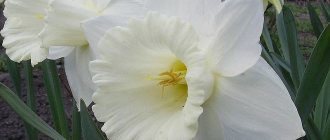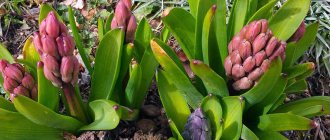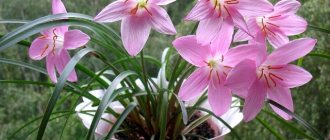Zephyranthes is an unpretentious, but unusually delicate and beautiful flower, named after the god of the west wind, and is very popular among flower growers. With proper care, the almost continuous flowering of zephyranthes lasts 4–5 months, and the rest of the time, as soon as the gaze touches its long green leaves, the memories of this event never cease to delight. The plant is ideal for beginning flower growers, because growing it at home is a pleasure!
Features and characteristics of zephyranthes
The main representative of the Amaryllis family can be safely called a perennial, represented by a bulbous plant called zephyranthes. This is a decorative flowering plant, as it gives beautiful inflorescences. Among the huge variety of marshmallows, we can safely say that a large number of varieties can be grown in a flower garden on the site, although the subtropical countries of Central, South and North America, as well as Argentina, are considered to be the birthplace of the plant. Remember, if your region is warm and harsh winters are more an exception than a classic, then growing zephyranthes in open ground is acceptable. As an alternative, you can grow zephyranthes at home, but with the arrival of summer, simply place flowerpots with a beautiful flowering plant on the streets, and with the onset of cold weather, bring them back into the middle.
The main name of zephyranthes is very complex for many, so a more “folk” version was rightfully adopted, which calls the flower “rain lily.” This name is quite expected, since the plant really has similarities with a lily in its flowering, although the size of the buds is significantly smaller in size, compared with the real “mistress”.
The root of the plant is a bulb, which has different diameters depending on the variety, but the average size is 3 cm. The shape of the bulb resembles an egg, which is covered with a rather dark shell. The bulb is the basis of the future plant, so it is at this moment that it must be strictly controlled. When planting zephyranthes in open ground, you only need to completely immerse the bulb in the soil - nothing else.
The foliage emerges directly from the bulb. They are long - 30 cm, narrow and linear, and the rosette itself is extremely narrow. Also, in addition to the foliage, a peduncle 20-25 cm long appears from the bulbs, at the end of which there is a single flower, which has a funnel shape, which is very similar to a lily. The diameter of the flower is not standard, since it all depends on the variety; the parameters range from 4 to 10 cm. The color range of the inflorescences is varied - pink, white, yellow, red. Multicolor inflorescences are popular, where several shades are combined, combining two or even more shades and tones in one petal, turning each flower into a real masterpiece.
The flowering period is a bright culmination that delights everyone, but this process can occur at different times of the year. Spring, summer or even winter is the prerogative of a single variety of zephyranthes. For open ground, the best varieties are those that are fragrant in the spring and summer.
Proper care
The development of an upstart can be divided into four stages:
Summer. The main period of growth. Lighting plays a very important role at this time. The flower can be placed in either bright sun or diffused light. Therefore, almost any window is suitable, except the northern ones.
- Watering is carried out regularly, as the soil dries, which should be slightly moist.
- If the air in the room is very dry, it is advisable to spray.
- The temperature of keeping pink marshmallow is from 20 to 30°.
Pink marshmallows on the windowsill (photo)
Autumn. The water regime becomes minimal as the plant prepares to rest. But while the foliage is still green, irrigation is still necessary.
- Just like outside, it gets cold in the house, which suits the flower entirely - only 18° is enough for it.
- The upstart should remain on the windowsill until it turns completely yellow.
Winter. For two to three months the culture goes into hibernation. She no longer needs light and water, so the pot is safely moved to a dark, cool place.
- Dried greens are removed.
Spring. To awaken, the zephyranthes returns to its window. In order for the onion to grow, the soil is watered abundantly. And in abundance. This is necessary to simulate natural conditions.
- The temperature gradually increases from 10° to 20°.
In principle, a rain lily can do without a dormant period. But then you can’t expect a spectacular appearance.
How to grow zephyranthes in your garden or flower garden?
As you know, zephyranthes can reproduce in two ways - by seeds and by dividing the bulb. The seed method for open ground is a practically impossible task, unless you patiently carry out all the preparatory work on the formation of a young plant at home, and only then transfer the plant to the site. Another thing is dividing the onion. The children that form around the main bulb need to be separated and planted in a new place, which will make it possible to successfully begin the growing season.
Zephyranthes is capable of forming more than 10 children in one plant, which are completely suitable for use as planting material. The process of separating the bulbs should be carried out no earlier than the plant is completely dormant, because this is the only way you will not be able to harm the main zephyranthes. Remember, storing bulbs in winter should be done exclusively at home. Further, there are two options - store the bulbs until spring in order to later plant them in open ground, or root them immediately and transplant a fully formed plant into the soil in the spring.
Reproduction methods
Daughter bulbs
An adult marshmallow bulb produces up to 10 babies per season
Zephyranthes is propagated using daughter bulbs only during the dormant period. In this case, you should adhere to the following sequence of actions:
- Prepare a sufficient amount of mixture from equal parts of humus, turf soil and fine sand.
- Take a shallow but wide container in which you intend to grow zephyranthes, pour drainage into its bottom (expanded clay or broken brick is optimal), then fill the pot with the resulting soil mixture.
- Spray the bulbs with Epin solution or soak them in it for 2–4 hours.
- Plant several bulbs in a pot, completely covering specimens with a short neck with soil or leaving the top above the soil if the neck is long.
- Water the planted bulbs.
Using seeds
In indoor conditions, zephyranthes are propagated very rarely using seeds, since due to the property of rapid loss of germination, the seeds must be planted immediately after collection.
If you have fresh marshmallow seeds, then you need to plant them in the usual soil for it, leaving 2-3 cm of free space between the seeds. Sprinkled with soil, the seeds are watered abundantly and, covered with plastic film or glass, placed in a shaded place with a constant temperature of about +22 °C. The appearance of the first shoots should be expected about a month after planting. The flowering of zephyranthes grown in this way can only be observed after 3–4 years.
Growing marshmallows from seeds is a labor-intensive process.
Video about flower seeds
Features of growing marshmallow varieties in open ground
Anyone who wants to have such a beautiful plant on their property as zephyranthes must understand that these plants are heat-loving, so they need a warm climate. In temperate climates, the process of growing marshmallows should be limited to growing in open ground only in the summer, and at home in cooler seasons. If the region is warm enough and belongs to the south, then planting zephyranthes in a flower garden is quite possible with full development and a successful ending. Let's look at common varieties that are ideal for growing on site.
If your climate is still moderate, then growing only those varieties that have only early flowering to their credit. Pink and large-flowered specimens of varieties are considered bright representatives. If zephyranthes will be used as an annual to enjoy during the summer flowering period, then feel free to choose the variety that you like, since everyone can bloom successfully.
Rest period
After flowering ends, the growth of upstart zephyranthes slows down, and the foliage of many species falls off. A period of rest begins, which lasts from 3 months to six months. Dry leaves are cut off, the pot is covered with a special covering material, and transferred to a cool, dark room with an air temperature of +8...+16C. During the dormant period of zephyranthes, you should monitor the soil moisture; the bulb should not dry out. As soon as new leaves appear, the flower pot is returned to normal conditions.
How to choose successful planting material?
Many flower growers are confident that purchasing from a specialized store is a guarantee of success. Alas, this does not always coincide with reality. Ordinary garden stores are just distribution points, so purchasing old or overdried bulbs may be no exception, which will ultimately ensure very long germination and a slow growing season. As a result, flowering appears in the 3rd or even 4th year of the growing season. There is a way out of this situation - the purchase of planting material should be carried out exclusively in nurseries or specialized centers for the sale of high-quality planting material. The ideal option would be to purchase bulbs that have already been planted in containers by professionals, observing optimal conditions and recommendations for each plant. This is the only way to have at least some guarantees and assert the quality of planting material.
Varieties of Upstart Flower
There are about 40 species of upstarts domesticated by humans. In general terms, zephyranthes is a plant up to 40 cm high. The rhizomes are bulbs with a diameter of 1 to 5 cm. They are covered with brown husks. The bulbs contain toxic substances, so they are not damaged by pests. The leaves grow immediately from the neck of the bulb, which can be long or short. The shape of the leaf blade is very elongated and narrow. The green leaves resemble ribbons 1 cm wide and up to 40 cm long. Peduncles are 10 cm smaller than the leaves. Several of them grow from the bulb, up to 30 cm high.
An ideal place on the site for growing marshmallows
After successfully purchasing planting material, an equally important step will be not only the correct planting in the flower garden, but also the choice of the optimal location. Since zephyranthes is a heat-loving exotic, only a sunny and warm place should be allocated for this flower. At the same time, fertile soils are a clear plus for the growing season, so when choosing a site, make sure that the soil is of high quality.
Zephyranthes can smell fragrant not only in a flower bed or flower garden; you can decorate rock gardens with this gorgeous plant, since the combination of inflorescences and stone can increase the value of not only the plant itself, but also the structure. Any hill can also be considered a good place for marshmallows, which will help avoid the accumulation of moisture, which is unacceptable for successful growth.
Superstitions
The sharp and long leaves of the plant.
The flower is surrounded by signs and folk beliefs. For example, it is believed that a plant has strong energy during the growing season - active growth and flowering.
Presumably, zephyranthes helps a person become more relaxed, courageous and self-sufficient. They also say that it strengthens the family, makes relationships more tender and warm.
However, the flower also has a bad reputation. In the teachings of Feng Shui, on the contrary, it is said that an “upstart” causes discord in family relationships, so it is undesirable to keep it at home, especially in the bedroom. Proponents of the doctrine believe that, in general, you should not have plants with long, sharp leaves at home.
The main rules for planting zephyranthes in open ground
- Boarding time. The first thing you should know is that planting occurs in the spring, but after the soil has warmed up as much as possible. That is why it is difficult to talk about an exact date; it all depends on your region. The main rule is to take your time so that the bulbs do not freeze.
- The soil should be properly prepared. For this purpose, it is best to completely dig up the area, loosen it, and only then level it.
- Humidification of the area. Next, the soil must be thoroughly flooded so that the area remains moist for a long time.
- Inspection of planting material . Before planting, you should inspect the bulbs again. Any suspicion of poor quality must be completely rejected for planting. Only high-quality bulbs should be planted - this is not a rule, but a law.
- Number of landings. The norm is to immerse one bulb in the soil. Alternatively, you can expand this rule and plant several bulbs at the same time.
- Planting depth. This moment depends on the filler material, or rather on the presence of a neck. If it is short, then the bulb is completely lowered into the soil, but long ones are left slightly above the surface level.
- Watering the planting. The final touch in planting will be watering.
Useful video
The video contains a lot of useful growing tips:
Zephyranthes is an indoor ornamental plant that will definitely not leave anyone indifferent. And growing it will not be difficult.
Read about other indoor bulbous plants: spiral albuca, amaryllis, wallota, hemanthus, hyacinth, hippeastrum, gloriosa, drimiopsis, Indian onion, calla, clivia, crinum, narcissus, nerine, oxalis, lily, scylla, freesia, eucharis. The catalog of all types is here.
How to care for zephyranthes in open ground?
The process of caring for zephyranthes in the open ground is a difficult but feasible task for everyone, because the main thing is to clearly know all the points that will favorably affect the development of the plant on the site.
- How to water zephyranthes correctly? Remember, the appearance of flower stalks and, accordingly, flowering depends on watering, so strict adherence to watering rules is the basis for successful flowering. Zephyranthes loves moisture, but not its abundance, so the quantity should be controlled. Make it a rule - often, but not too much. Excess moisture means the bulb can begin to rot, which will ultimately destroy the entire plant. Watering should be done only at the root and not with cold water. The ideal option would be settled, warm water. With the onset of dormancy, as evidenced by the complete loss of leaf mass, it is imperative to completely stop watering.
- Basic rules for feeding marshmallows. In order for the plant to enjoy bright and fragrant flowering for a long time, fertilizer should be applied at the beginning of the appearance of buds. Mineral complexes are suitable for these purposes, which will fully provide the necessary nutrition that the rain lily so needs.
- Loosening rules. Adequate oxygen supply is an important aspect of the growing season. That is why loosening is an element of care that should not be disturbed. Make it a rule to fluff up the soil after each watering. You should not neglect the procedure, but at the same time, there is no point in overdoing it either. Control the bulb, you should not injure it.
Temperature
Despite its tropical origin, the flower does not like being kept too hot. During the most active growth period, the maximum permissible room temperature will be +25C. If it is cooler, it will only be good. It would be great if it were possible to provide the marshmallow with a temperature regime in the range of +10...+14C, but, alas, in home conditions this is usually impossible, especially in the summer. In the cold season, the flower can be taken out into an unheated room, but it should be remembered that the lower permissible limit is a thermometer reading of +5C.
It is important to remember that zephyranthes tolerates cold conditions much better than hot ones.
Requirements for soil mixture
The main requirement for the soil is its looseness. If it is not possible to buy a ready-made soil mixture for bulbous plants, you can take equal parts of sand, humus and garden leaf soil.
The process of digging up bulbs and storing them
It is not recommended for bulbs to overwinter in open ground, so it is best to dig them up for the winter. For these purposes, the “harvesting” procedure should be carried out before the first frost - in the fall. The excavation process occurs with the presence of the entire above-ground part. The bulbs should be dried along with the foliage. You can get rid of the foliage after complete drying. Next, the bulbs are cleaned and immersed in dry containers that are pre-filled with sawdust inside. There is no need to create special conditions; standard room temperature will do.
Growing exotic plants on your own property is not such a common occurrence, although if you follow all the rules, you should not rule out the possibility of growing zephyranthes in open ground.
Join our Facebook group
Reviews
Ekaterina
I don’t know whether I should believe popular superstitions, but when the Zephyranthes appeared in my house, there were much fewer disagreements and scandals. I have white, pink and yellow-orange upstarts, the first ones produce one bud after another, but the two-colored one does not bloom so magnificently and the point is not in the age of the bulbs, but in the variety itself. While I was getting used to the new plants, I made a mistake - I watered them very often and abundantly. Some of the bulbs rotted, the rest were treated in a weak solution of potassium permanganate and transplanted into a new substrate, everything worked out.
Anastasia
I love Zephyranthes, it is absolutely not a capricious flower, all it needs is a period of rest and proper watering. I replant only when the bulbs occupy the entire earthen ball; every year I enjoy the lush lace of white, pink and yellow flowers. It’s just a pity that each bud only lives for 2 days and then fades. In the summer I move the pots into the garden and place them under tall hostas. I live in Rostov, but I don’t dare to plant bulbs in the OG, but my neighbors have them, and they cover them with leaves for the winter. There were no diseases or pests, nor any other problems.










